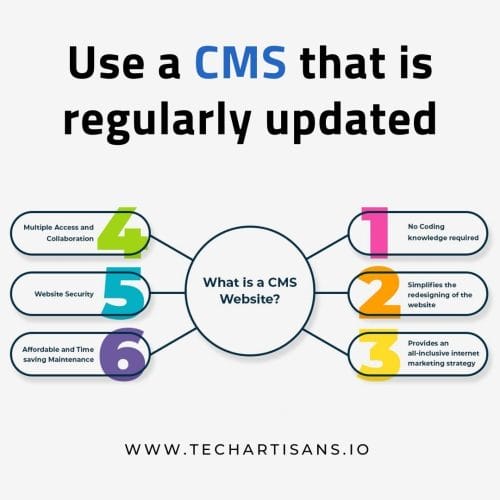Future-proofing your website ensures its longevity and success in the constantly evolving digital and social media landscape. It safeguards your website from becoming outdated, having poor user experience, lower search engine rankings, and decreased traffic and conversions in upcoming few years.
In this article, we have provided you with a guide to future-proofing your website which involves implementing best practices and staying up-to-date with the latest industry trends and technologies so you keep on attracting new clients and growing your business.
Checklist for Future Proofing Your Business Website
Below is a list of the elements to consider to ensure that your website withstands the test of time and meets the needs of the ever-changing digital world.
1. Choose a Reliable Hosting Provider

Choosing a reliable hosting provider ensures your business website’s performance, availability, and security.
A hosting provider is responsible for storing your website files and making them accessible to clients online.
If your hosting provider experiences frequent downtime, slow loading times, or security issues, it can negatively impact your website’s user experience, search engine rankings, and overall success.
For more insights, read our article on How to Choose a Web Hosting Provider
Here are some key factors to consider when choosing a hosting provider for creating a future-proof website:
Uptime: Uptime refers to the time your site is accessible and available to visitors. A reliable hosting provider should guarantee high uptime, ideally at least 99.9%. Good uptime ensures that your website is always accessible to visitors and minimizes the risk of losing traffic and revenue due to downtime.
Security: Look for features such as SSL certificates, firewalls, and regular backups to protect websites from cyberattacks, malware, and other security threats.
Regular backups are key to website security. Explore our insights on the Importance of Regular Website Backups

Scalability: Your hosting needs may change as your site grows and attracts more traffic. Your hosting provider should accommodate your changing needs by offering scalable hosting plans and resources.
Customer Support: Look for a hosting provider that offers 24/7 support via multiple channels, such as phone, email, and live chat.
Price: Look for a hosting provider with a good balance of affordability and reliability.
2. Use a CMS That is Regularly Updated

Using a Content Management System (CMS) that is regularly updated is crucial to maintain and future-proof your business website’s security, performance, and functionality.
A quality Content Management System software platform allows you to easily create, manage, and publish new content on your site. Popular CMSs include WordPress, Drupal, Joomla, and Magento.
Here are some tips for keeping your CMS up-to-date to future-proof website:
Enable Automatic Updates: Many CMSs allow you to enable automatic updates, which can help ensure that your website is always running on the latest version of the CMS.
Check for Updates Regularly: If automatic updates are not enabled, check for updates regularly and install them as soon as they become available.

Backup Your Website: Before installing updates, back up your site to ensure that you can easily restore it if something goes wrong during the update process.
3. Implement Responsive Web Design

Implementing responsive design is an essential step in future-proofing your website. Responsive design provides an optimal user experience across all devices and screen sizes, from desktops to mobile devices.
Discover more about the importance of responsive design in SEO in our detailed article SEO Responsive Web Design Benefits
With responsive web design, the layout and valuable content of your website adjust dynamically based on the size of the user’s screen. It plays an important role in the SEO of your landing pages since Google ranks responsive websites higher than those that are not.
Here are some key principles of responsive design to future-proof your website:
Flexible Grids: Responsive design uses flexible grids that adjust based on the screen size to adapt to different screen sizes while maintaining a consistent design.
Fluid Images: Images on a responsive website should be flexible and resized based on the screen size to look good and load quickly on all devices.

Media Queries: Media queries apply different styles and layouts based on the screen size to create a great website on all devices.
Mobile-First Design: Mobile-first design is an approach that involves designing for mobile devices first, then scaling up to larger screens so the website is optimized for mobile devices and provides a good user experience on all devices.
4. Optimize Your Website for Speed

Website speed is the amount of time it takes for a website to load completely. Therefore, optimizing your website for speed is crucial in future-proofing your site.
A slow website can negatively impact user experience, lead to a high bounce rate, and affect your search engine rankings. With a slow loading speed, you will not get the desired results no matter how smart your digital marketing strategies are.
Enhance your website’s performance by reading our article on Web Performance Best Practices
Here are some tips for optimizing your website for speed:
Content Delivery Network (CDN): A CDN can help distribute your website’s content across multiple servers, resulting in faster user load times.
Optimize Images: Use compressed images and optimize their sizes to improve website speed.
Minimize Code: Minimize the size of HTML, CSS, and JavaScript files with clean code to improve website speed.
Reduce Third-Party Scripts and Plugins: Minimize third-party scripts and plugins that can negatively impact website speed.

Use Caching: Use browser caching and server-side caching to improve site speed.
5. Use Structured Data

Structured data is a standardized format for providing information about a website’s content to search engines.
It uses a specific vocabulary, such as schema.org and site architecture, to label and organize the information on a website so that a search engine can easily understand the content and display it as more useful and relevant in search results.
Structured data helps search engines better understand your content. Learn how to implement this effectively in our article on How to Use Structured Data
Here are some steps to implement structured data on new websites:
Structured Data Format: Choose a structured data format that is relevant to your website’s content and is supported by the search engine.
Use Schema Markup: Use schema markup to add structured data to your website’s content. You can use tools like Google’s Structured Data Markup Helper to generate schema markup.

Test Your Structured Data: Test your structured data using Google’s Structured Data Testing Tool to ensure it is properly formatted and visible to the search engine.
6. Implement HTTPS

HTTPS (HyperText Transfer Protocol Secure) is the secure version of HTTP, the protocol used to transfer data between a website and a user’s browser
HTTPS uses SSL/TLS encryption to protect the privacy and security of user data, such as login credentials, credit card information, and personal details.
HTTPS is crucial for securing user data. For a deeper understanding, read about the Benefits of Progressive Web Apps which include HTTPS implementation.
HTTPS helps prevent eavesdropping, tampering, and other types of cyberattacks.
Here are the steps to implement HTTPS on your website to future-proof it:
SSL/TLS Certificate: You can obtain an SSL/TLS certificate from a trusted Certificate Authority (CA), such as Let’s Encrypt or Comodo.
Many hosting providers also offer SSL/TLS certificates as part of their services.

Install the Certificate on Your Web Server: Once you have obtained an SSL/TLS certificate, you must install it on your web server.
Your hosting provider or web developer can assist you with this process.
Update Your Website’s URLs: Once you have installed the SSL/TLS certificate, you need to update your website’s URLs to use the HTTPS protocol instead of HTTP.
This may involve updating links, images, and other content on your website.
Test Your Website: Once you have implemented HTTPS, you should test your website to ensure everything works properly. You can use tools such as SSL Labs to test the security of your website.
7. Regularly Backup Your Website
Regularly backing up your business website is essential to quickly recover from data loss, security breaches, or other types of disasters. It gives you peace of mind, knowing that your website is safe and that you can restore it to its previous state if necessary.
Here are a few tips for backing up your website in the future proof website:
Use a Backup Plugin: Many content management systems, such as WordPress and Drupal, have backup plugins to help you create regular website backups. These plugins can automatically back up your website to a remote server or cloud storage, ensuring your data is safe and secure.
Use a Reliable Backup Service: You can also use a reliable backup service to back up your website regularly. These services typically offer automated backups and the ability to restore your website to a previous state in case of a disaster.

Test Your Backups: It’s important to test your backups regularly to ensure they work properly. In addition, you should try both the backup and restore processes to ensure that your backups are reliable.
Store Backups Securely: It’s important to store your backups securely to prevent unauthorized access. For example, you can keep your backups on a remote server or cloud storage or store them locally on a secure device.
Conclusion
In today’s age of digital marketing and social media, in addition to social media accounts, having a website is crucial for businesses or individual who wants to establish a strong online presence. However, to ensure that your website remains relevant and runs your business operations smoothly in the long run, it’s important to future-proof it by following the steps outlined in this guide.
Future-proofing sites is not a one-time task but an ongoing process. As technology and user behavior evolve, you must continually adapt and improve your website to stay ahead. Following the steps outlined in this guide and keeping up with the latest trends and best practices, you can future-proof your website and ensure its success in future years.







